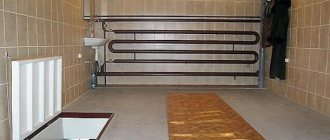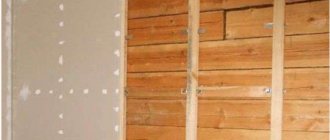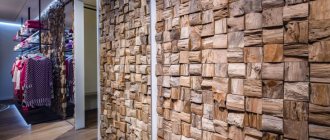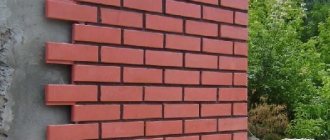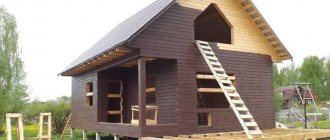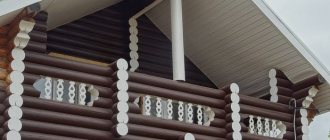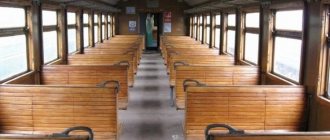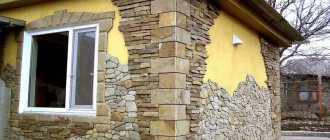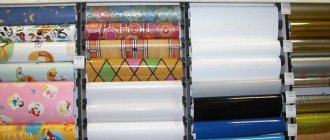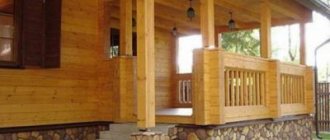ps They really helped us, so advertising is free))
Published on 10/25/2018 by Stroitel
The interior decoration of a house made of timber is a continuation of the construction work on assembling the structure, which must be completed by this stage. This is a very responsible process, because it is the mission of giving the living space comfort and coziness in accordance with the given design. In our article you will find useful information on this topic and learn where to start with the upcoming repairs.
Features of wooden houses
The interior decoration of a house made of timber is not fundamentally different from a brick or block frame. You just need to take into account a few features:
- complete shrinkage of the log house lasts several years;
- over time, the gaps between the beams expand;
- wood requires mandatory protection from moisture.
Because of such nuances, you cannot rush to begin interior decoration, otherwise cracks will appear in the walls and ceiling. To avoid troubles, it is necessary to coat the wood with a protective varnish in the first year after construction of the frame.
It is recommended to make the floor two-layer, consisting of a rough and a main row. And either leave the ceiling with open beams or cover it with PVC fabric.
Builders advise following a certain order when finishing a wooden house:
- Laying utilities on top of the subfloor
- Basic flooring
- Treatment of timber (filling cracks, filling, applying antiseptic, decorative finishing)
- Ceiling decoration (puttying and varnishing of beams, installation of finishing coating)
The advantage of laminated veneer lumber is that it shrinks less than other types of wood. Source indeco.ru
In a new house, it is better to leave the original appearance of the timber - environmentally friendly, natural, smooth.
And if the log house has stood for several decades, then it is advisable to cover it from the inside with modern finishing materials, since restoring the appearance of the tree will be difficult and expensive.
Application of various compositions
For the interior decoration of a wooden house, several types of compositions are used: varnishes, paints, mastics, oils. They can be transparent, tinting and impregnating, but all have the main purpose - protecting wood from moisture and rotting.
Ways to protect wood from rotting
For interior work, glossy, matte and semi-gloss varnish compositions are used. The most commonly used materials are water-based, which eliminates strong odors, although it somewhat lengthens the drying time. If quick drying is necessary, you can use nitro varnishes, which require careful ventilation after completion of work. The glossy variety is intended for hallways, living rooms, and common areas. The matte option is more suitable for bedrooms, especially children's bedrooms.
For interior work, glossy, matte and semi-gloss varnish compositions are used.
Paints are used to create an opaque coating and are often combined with the application of plaster. The main advantage is the ability to provide any color scheme in accordance with the chosen interior. Acrylic paints and enamels are widely used.
Painting timber walls
Wax mastic can be transparent or in various shades to emphasize the wood texture. It reliably protects the timber from moisture and preserves the natural pattern of the structure for a long time. This material has an increased cost, but it does not form a surface film, which provides a breathing effect for the wood.
Wax mastic for walls
Impregnation with an oil composition protects the wood from rotting and provides a golden hue while maintaining the texture. Natural oils are used: linseed oil or so-called Danish oil obtained by cold pressing.
Danish oil for wooden walls
Types of interior decoration
Glued laminated timber does not require additional cladding. It looks perfect even without varnishing. If the walls are made of profiled wood, you will have to think about finishing.
Wood needs protective impregnation in any case. It creates a barrier against fungus, mold, moisture and even fire. Can lighten or leave the surface color unchanged.
Low-quality profiled timber can be easily hidden under panels that imitate natural wood from lining, block house or siding - this way the inside of the house will not only maintain eco-style, but will also become warmer.
It is also possible to create a modern interior in a wooden cottage. The timber can be easily sheathed with plasterboard or OSB panels, painted, covered with wallpaper, or covered with artificial stone. And hide the electrical wiring inside.
Imitation of real timber in the living room Source budavnik.by
Floor installation
Before you start finishing work, be sure to think over the design of a house made of timber: the interior decoration of the house directly depends on the project. Based on it, the cost estimate is calculated.
A conscientious construction company has specialists in 3D interior design, estimators, and experienced installers. They will quickly and efficiently fulfill all your wishes, making your dreams come true.
Installation begins with the subfloor. Regardless of the finishing materials chosen, the surface of the lag is first treated with protective impregnation against moisture. Insulation (mineral wool or polystyrene foam) is placed between them. Then a substrate made of chipboard or OSB board is attached. And a finishing coating is already laid on top of it. It can be natural board, linoleum, laminate, parquet or artificial stone.
An added plus! Double flooring will help keep the house warm.
Popular floor coverings
In a wooden cottage, the floor is often laid with planed tongue-and-groove boards made of pine or spruce. It does not require maintenance and retains its original appearance for several decades. And when it gets dark, you just need to sand the top layer and re-coat it with a protective composition.
Tongue and groove board without varnish coating Source pol-master.com
See also: Catalog of companies that specialize in finishing and insulating houses.
The only contraindication is the installation of heated floors. This is a fire hazard and impractical, because most of the energy will be spent on heating the wood.
Laminate and parquet conduct heat well. These coverings look similar to plank floors, only with a more interesting pattern. You can create an original pattern from parquet planks. And the laminate is strong enough, it is not pressed through by heels and furniture legs. Imitates different types of wood, metal and stone.
Laminate with imitation stone in a wooden house Source parketgrup.ru
Artificial stone on the floor enhances the interior. It is best to install this material in the bathroom, hall or kitchen. To keep your feet from freezing, a heating system is needed. The main advantage of a stone floor is its durability and unique pattern. This type of floor design requires plaster and stone on the walls and ceiling.
Artificial stone on the floor looks luxurious Source spainproject.ru
Linoleum is the most affordable wood imitation. Its service life is no more than 10 years, so it is often installed as a temporary coating.
Wall decoration
Wooden walls are first impregnated with an antiseptic, and then treated with varnish, paint, mastic or oil. Choose a solution based on the expected effect. If the surface needs a tinted matte finish, then mastic or acrylic paint is suitable. For an elegant gloss, the timber is coated with oil or varnish. The texture of the wood does not change from such solutions, but moisture is not a problem in the coming years. Wax-based mastic has a porous structure that allows air to pass through, and oil gives a beautiful golden shine.
When the impregnation has dried, the finishing of the house from the profiled timber from the inside begins. The lining requires a wooden sheathing. Steam and heat insulating sheets are placed in the spaces between the slats. The boards themselves are nailed to the slats at the edges. And they are connected to each other using grooves. The lining can be placed vertically, horizontally or diagonally. If you combine these methods, you will get a unique drawing.
Lining on the wall is ideal in a wooden house Source opora-stroy.ru
Features of floor arrangement
Floor installation in a wooden house.
A wooden house can be equipped with almost any finishing floor covering, it could be laminate, ceramic tiles or, for example, parquet. If a water heating system is used, it is not recommended to combine it with parquet or solid boards, which do not tolerate temperature changes and have low thermal conductivity. The most common option for a private house is a foundation on logs. The main thing to do when arranging the floor in this case is to eliminate vibration and insulate it well. For wooden houses, the most recommended floor covering is a solid board made from natural wood. Parquet boards, laminate and cork are also often used, the latter of which is a modern, natural, environmentally friendly material that can provide the floor with additional insulating characteristics.
https://youtube.com/watch?v=eH7LWNMJZ78
When finishing a wooden house, it has many advantages compared to buildings of a traditional type, due to the fact that walls, floors and ceilings do not need to be insulated as carefully as in the case of brick houses. Since wooden houses are much warmer.
Prices in Moscow for interior decoration of a house
What budget should the owner of a wooden house expect for a construction company to complete the interior finishing? It all depends on the complexity and volume. On average, an installation team in Moscow asks for 80 rubles/sq.m. for applying impregnation in one layer. m., oils – 100 rub./sq. m, varnish or wax – 150 rub./sq. m. Painting the inside of a log house will cost 200 rubles/sq.m. m. Plus the cost of the solutions themselves.
Installation of an aluminum frame for any finishing panels - 300 rub./sq.m. Covering a room with plasterboard – 300 rubles/sq.m, vinyl siding or panels without insulation – 600 rubles/sq.m, and with insulation – 700 rubles/sq.m. Plus the material itself.
Selecting Tools
To apply the listed materials, it is better to use paint brushes with dense synthetic bristles. The exception is universal solid oil 245 - you can use a brush with natural bristles to apply it. It is not recommended to use sprayers due to the thicker application of paint, which not only results in excessive consumption of materials, but also takes a long time to dry.
The choice of brush is also important: a high-quality brush with dense bristles will allow you to apply the paint faster and more evenly without leaving marks. Cheap brushes with loose padding tend to leave marks on the surface and do not allow you to achieve an even, thin layer.
Video description
What and how much in finishing a wooden house - look at the video:
Installation of block house panels is a little cheaper - 450 rubles / sq.m. excluding lathing and related work.
The cost of gluing artificial stone to a wall is at least 1200 rubles/sq.m, but this is if the surface is already prepared. The cost of turnkey work is at least 10,000 rubles/sq.m.
Laying tongue-and-groove floorboards will cost 600 rubles/sq.m including joists, parquet without sanding – 600 rubles/sq.m, laminate or linoleum – 250 rubles/sq.m.
Covering the ceiling with clapboard costs from 500 rubles/sq.m., plasterboard – 450 rubles/sq.m. And installation of stretched PVC fabric will cost from 550 rubles/sq.m. excluding material.
Finishing of ceilings
Painting. Often the finishing for the ceiling is beams and their filing. Often, owners want the house to look like it was in the old days, so the ceiling beams are not hemmed from below. They are simply sanded or artificially aged and then covered with paints and varnishes.
Wood paneling. As in the case of walls, imitation timber is often used for finishing. A ceiling made of such material will fit very well into the interior, even if only painting was used to decorate the walls. Other wooden materials can also be used. Separately, it is worth noting the slatted wooden ceiling, when boards or slats are sewn on with a gap. The lathing is made from ceiling sticks that are already level and perfectly flat.
Unusual options for finishing a wooden house
Even from familiar materials you can create an original design for the inside of a wooden house. Like, for example, a clapboard ceiling with carved elements.
Carved clapboard ceiling Source yenni.biz
Or the silhouette of a Japanese tree made of stones on the wall. The base is covered with the same tiles
Stone tree on the wall Source nkkconsult.ru
Parquet in skillful hands is a real work of art. Don't need no carpet
Unique pattern from parquet boards Source assz.ru
Custom brutal design
To create a truly non-standard interior, bold designers recommend highlighting all the flaws of the timber. Dark shades will add special charm to the design. However, do not overdo it, otherwise the room will look gloomy. Unprocessed hand-cut logs with a superbly painted texture are suitable for these purposes. The texture is painted with water-based paints. The result is a log house in a brutal rustic style.
A feature of the house will be a Russian stove made of untreated stone. You can complement the interior with a table and chairs made of the same rough wood. All textiles (chair covers, curtains, blankets) are designed in cool colors. Folk ornaments and soft carpets in a rustic style are welcome. To play with contrasting textures, add an antique leather chair. An unexpectedly bright terracotta spot in the form of a sofa blanket can refresh the interior.
In such a wooden house you should not strive for an ideal surface. But there is no need to be deceived. Any carelessness added to modern design requires strict calculation, as well as scrupulous selection of colors. It will take a lot of time to experiment, since each type of timber requires its own tone and finishing application technique. Before you create such a rustic interior, you should practice on scraps to choose colors. Plus, you need to do the same procedure on another piece of wood to consolidate the skill. And only then start decorating the inside of the house to get the design as in the photo.
As for what the interior of a bedroom inside a wooden house should be like, it certainly seems cozy and intimate. Everything in this room should set you up for relaxation. As a rule, in a house made of timber, these rooms are decorated in light pastel shades. And only the details help to place a couple of color accents. A whitewashed log house and contrasting dark furniture may predominate here.
Wooden house bedroom design
Russian hut as an interior style for a wooden house
If you decorate the interior of wooden houses with a massive fireplace and an abundance of antique objects, it will turn into a Russian hut, as you can see in the photo.
The Russian hut is an abundance of ancient objects. Pots, large ornaments, scarves, towels, a large massive fireplace. Windows must certainly be wooden. It is better to exclude plastic ones. Furniture is made of unpolished wood, preferably artificially aged. All pots, cabinets and shelves are carved. The dining table is massive, large, and next to it there are long benches. You can put strong wooden simple chairs. Beds with carved headboards, chests instead of bedside tables and wardrobes. The sofa is upholstered in natural colored linen. It is better to buy lamps in the form of lamps and candles. Decorate the walls with embroidered panels, embroidered bags with spices and herbs.
Solid furniture, not polished or painted, would look ideal in the kitchen. Let the kitchen set have rough wooden facades, perhaps carved or decorated with paintings with folk motifs.
Eliminate glossy facades, all reflective surfaces, suspended ceilings, aluminum frames and glass inserts. Order built-in equipment. In order not to negate the whole impression, install it in antique furniture. Do not buy any plastic, metal or glass items.
For decoration, buy wicker baskets, a samovar, barrels, wood products from craftsmen, and pottery. You can hang a wooden wheel on the wall. There should be round home-woven rugs on the floor. Fishing gear, a spinning wheel and an antique foot-operated sewing machine will not be out of place in this house. Embroidered linen fabrics will also look great.
Design of a wooden house in the style of a Russian hut
Design of a wooden house in the style of a Russian hut
Why do you need to paint the inside of a house?
Firstly, painting the inside of the house, provided all requirements and application technology are met, will favorably emphasize the structure and individual natural pattern of the wooden surface. Painted wood will become a real highlight in the interior and will help put an end to the embodiment of the design idea.- Secondly, the paint will protect wooden surfaces from their main enemy - moisture. Accumulating in a living space, moisture in the form of steam settles on the interior decoration of rooms and can penetrate unprotected walls. If you do not want moisture penetrating into the structure of wooden materials to lead to swelling, deformation and cracking of wooden finishing fragments, you should apply and renew a layer of paint inside the house. Excessive moisture in wood materials can also lead to mold, discoloration and loss of aesthetic appeal. Therefore, protecting wood with paint is an excellent and practical solution.
Wood is becoming more and more popular and is quite often used in private individual construction. Developers love it for its environmental safety, excellent permeability (the most “breathable” material), and the ability to maintain an optimally comfortable indoor microclimate.
Painting the walls inside the house with paint makes it possible to maintain all the above advantages of wooden materials at the proper level. In our article we will look at the main types of paint and varnish products, help you decide on the type of coating to choose and discuss the technology of applying paint to wooden surfaces.
Choosing a style for decorating a house made of timber
To create a holistic and organic interior, it is important to plan the design of each room in advance, determining the style direction. Here it is important to take into account the financial capabilities of the homeowner and his sense of taste, the preferences of family members and other factors. You can decorate a home made of timber in one of the following styles:
- Hunting style or chalet is the optimal solution for a small country house or country house. The decoration is dominated by wood and stone.
- Russian style - the timber is left untouched, supplemented with boards or laminate. The central element of the interior is a massive stove.
- Provence or Scandinavian style - finishing with light materials, complemented by bright accents.
- Minimalism is a modern style where large features dominate. The timber can be complemented by glass and metal surfaces, light colors and a minimum of decor.
Timber painting
Wood shrinks less if it is covered with a layer of paint.
The interior decoration of a log house intended for living is carried out with natural-based products or artificial materials that are safe for health.
Wood darkens over several months of use of the premises, so it is better to paint the surface immediately after the construction of the roof is completed.
Varnish or paint will protect the timber from rotting and damage by pests.
If the final version provides for wall cladding with any materials, the walls can be painted in any color.
If it is necessary to preserve the structure of the tree or add shade, proceed in a different sequence:
- The timber is sanded, removing uneven walls and roughness.
- The wood is treated with an antiseptic, which contains a fire retardant that prevents combustion.
- The darkened surface is first restored with bleaches.
- After the wood has been soaked, final sanding is done.
The process of decorating the walls is completed by painting.
To obtain a smooth surface, thoroughly clean the premises and remove dust.
Walls can be coated with linseed oil and wax
The wax covering the timber gives it a velvety appearance. Transparent waxes preserve the structure of the wood. The option is not cheap. When applying, it is necessary to follow the manufacturer's recommendations regarding temperature, consistency of the composition, as well as the microclimate in the room.
Oil or acrylic paints are rarely used, as they completely hide the wood pattern.
Acrylic transparent interior varnish is applied after preparing the surface, the number of layers is at least two. Between applications, you must wait for the first layer to dry completely.
It is advisable to apply any coloring substances in one step to the entire wall. Interruptions in work can lead to uneven painting and the appearance of a camouflage effect.
Glaze paints leave the wood structure visible
Glaze paint is a translucent coating that keeps the wood structure visible. The color is selected by introducing pigment into the paint composition.
It is better to entrust the selection of paint to the store employees. It is important to remember the shade number so that if there is a shortage of paint, order the exact same one.
All work can be done with a minimum set of tools. You will need:
- surface scrapers;
- grinding machine with a set of sandpaper;
- roller and brushes.
The advantages of painting include easy restoration of damage and the ability to repaint the room if necessary.
Ceramic tile
- reliable and inexpensive;
- suitable option for bathrooms and toilets;
- complex installation.
Another good answer to the question of how you can inexpensively and beautifully cover the walls of your home, if it is made of wood. Good - in terms of material costs and the final decorative effect. However, in order to lay the tiles evenly and correctly, you cannot do without special skills. Still, good specialists are worth it.
The tiles are glued to the base surface using tile adhesive, and after direct cladding, the seams are sealed with fugue - a special grout that prevents the appearance of pathogenic flora on the walls of a wooden house and, at the same time, by adding various dyes, also helps to emphasize certain shades in the interior.
Useful recommendations for purchasing paint and painting
When choosing and purchasing paint for the interior decoration of wooden walls, it is very important to pay attention to the date of manufacture of the composition and the availability of certificates confirming its quality and sanitary compliance. If the seller cannot provide documents for the product, and the production date is not stamped on the packaging, but is written on paper and pasted on top, so to speak, interrupted, then it is recommended to immediately refuse to purchase such paint, especially if a fairly expensive version is purchased.
The fact is that if the paint is expired or frozen, then it may simply not lie on the surface, even if it is well prepared, and you can determine the quality of the composition only by opening the package and trying to apply it to the wood. For example, it will not be possible to paint anything with a frozen solution, since the paint will most likely curdle and have the consistency of liquid cottage cheese.
High-quality paint should spread easily over the surface of the wood, while having high hiding power
If the paint is of high quality, it will be easily applied to the surface, which means that painting the walls can be done by a person who has never even performed such repair work before.
Next, it is worth considering those factors that will directly affect the final finishing result.
- First thing to note. It is a common phenomenon that many homeowners, when doing their own renovations in a house or apartment, are careless about the preparatory stage of work, since they consider it unnecessary. However, if the base for the decorative coating is uneven and untreated with protective agents, you should not expect the desired result. In addition, after a short time, even defects that are invisible immediately after completion of the work will begin to appear, for example, such as blue discoloration, blackness of the wood, or “resin pockets” near knots. Therefore, the preparatory process must be considered mandatory and carried out as efficiently as possible.
- When treating wood with one of the protective compounds, it is necessary to very carefully process the end parts of logs or beams if they face the rooms. If the walls of the house are covered with clapboard, then its side surfaces should also be carefully treated with antiseptic solutions.
- All protective and coloring compounds are applied to wooden surfaces in thin layers along the grain, otherwise their absorption into the wood will be uneven, which will negatively affect the overall appearance.
This simple “improvement” from ordinary rubber rings will greatly simplify the process of applying paint with a brush from a can.
- To ensure that there is no excess paint on the brush, and that it does not flow, but lies flat, it is recommended to use a simple device consisting of two stationery or ordinary rubber bands. One of the rubber bands is put on the bottom and top of the can, and the second along its diameter. The second elastic band will hold the first one, preventing it from sliding to the side.
After dipping the brush into the paint, press it against the stretched rubber band, leaving excess solution in the container.
- When applying paint to the surface of wood, do not try to cover it with a thick layer at once, as the painting will turn out sloppy. If you plan to get an opaque surface, then you should apply the paint in several thin layers, each of which should be applied after the previous one has completely dried.
- When painting walls covered with wooden clapboards, it is best to apply the final top coat starting at the top and gradually moving down - this method will help make the surface of the wall smooth.
- Paint can look different in a can and on the wall, so it is recommended to do a test paint job, that is, apply the solution to a small section of the wall in an inconspicuous area. It is best to choose the lower corner part of the surface.
- In order for the decorative layer to lie evenly on the surface, experts recommend adding a color to the primer that is one or two tones darker or lighter than the base color.
- The optimal temperature for painting surfaces is 22÷25 degrees. You should not carry out this process in hot weather, as the paint will dry too quickly and therefore unevenly. If the temperature is too low, the fluidity and hiding power of the compositions deteriorate, and the drying period increases.
Finishing the premises with clapboard, block house
These materials are similar in the method of fastening, so there is no point in considering each separately. Siding is rarely used to decorate the inside of a timber house, but the owners love the lining and block house. Finishing with these materials is carried out holistically and does not require additional processing. The exception is unpainted lining, which is pre-varnished with paint or glazing compounds.
The main advantages of the material include:
- The plastic version has high moisture resistance, and the wooden one will not interfere with the environmental friendliness of a house made of timber.
- Easy to clean from dirt and dust.
- Easy to install.
- Durable material.
- Wide range of color options.
- Can be combined by color or with other material.
To work you will need:
- Material and components (for siding and block house)
- Screwdriver.
- Bars 25x50 mm - without insulation and 50x40 with insulation.
The lathing is attached to the walls in increments of 40 cm, perpendicular to the fastening of the lining or block house. A vapor barrier and insulation are laid (more about this is described in the article on insulating a wooden house from the inside).
Features of installation of lining and block house
Using a level and a screwdriver, a guide block is attached; the first link of the casing will go from it. You need to fasten the clapboard and block house made of wood using thin nails. There are two ways: the nail is driven into the lock and from above. Plastic panels are secured with self-tapping screws using a screwdriver. It is worth noting that vertical mounting visually increases the height of the ceiling, and horizontal mounting expands the room.
Sheathing using lining
The interior decoration of a house with wood offers a wide variety. Lining guarantees an abundance of shapes, widths, and special textures depending on the type of wood. You can divide the lining based on the transverse profile into the following types:
- American.
- Landhouse.
- Blockhouse.
- Standard.
- Softline, etc.
The fastenings are also different:
- Using clamps.
- Using screws and nails at an angle.
- Nails into the face. This method is not very common because it is considered not very attractive from an aesthetic point of view.
Self-tapping screws with nails and clamps are not simple; it is necessary to fasten them and prevent deformation of the lining on the front side.
Self-tapping screws or nails are often replaced with special construction staplers with staples. This allows the use of staples with a narrow part on the “back” side and with long legs. The fastening materials are based on special metal compounds, steel with anti-corrosion treatment.
Wood is used as the basis for the lining, which means shrinkage is also relevant. If chamber drying has been carried out, the material will be of the highest quality. However, purchasing kiln-dried lining is not so easy, so many homeowners who are finishing it choose more affordable options. The following nuances need to be taken into account:
- When securing it initially, you need to remember that the cladding will have to be dismantled, so you should decide on the appropriate tools: screws or nails.
- If you follow aesthetic considerations, you can dismantle the lining and then nail it again.
- It is possible to leave the surfaces in their natural form - as is.
- If natural drying has taken place, then gaps will appear between the finishing elements.
Painting a house: choosing a coating
Varnishing adds shine and durability to your home.
Paint and varnish compositions for interior work can be natural (impregnations) or synthetic (paints).
Natural varnishes and paints are produced on the basis of natural oils or water. At the same time, natural wood impregnations can be transparent and tinted.
To paint the interior of your home, it is better to use natural-based paints that do not contain substances harmful to health.
You should choose a coating based on its purpose in the room. Water-based paint is good for the walls of living rooms, but for the floor it is better to use more wear-resistant compounds.
In rooms with high humidity, such as a bathroom or even a kitchen, it is better to choose a paint that is resistant to moisture.
Pokarska in light colors
Many manufacturers also include substances in their coatings that can protect the surfaces being coated from the formation of mold; this is worth paying attention to.
The color scheme is a purely individual matter. Options for painting a house can be very different. In terms of structure, the shade of the coating can be:
- matte,
- semi-matte,
- glossy,
- semi-gloss.
Everyone chooses house painting colors to their own taste. Here we will only replace that all shades of color are divided into cold and warm, matte and glossy.
Surfaces painted with gloss paint are brighter and bolder. These paints are best used in active rooms – living room, kitchen, etc. Matte shades provide a softer color cast on a painted surface and are great for a bedroom or children's room.
Preparation for finishing
It is not always advisable to veneer walls from the inside. If the inter-crown insulation is invisible, and the design is neat and tidy, then the sheathing can be abandoned and replaced with cheaper, practical paints and varnishes. However, if the caulking seams are unattractive, there are surface defects, and the texture is uneven, then only finishing will correct the situation.
It is very important to protect wood from mold and mildew, regardless of the characteristics of the materials used. Manufacturers offer effective, safe, inexpensive antiseptics especially for such purposes. Additionally, you can take fire retardants, which, as the name suggests, make the texture non-flammable.
